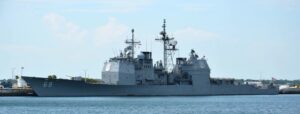The Senate Armed Services Committee’s (SAC) FY 2023 defense authorization bill directs the Government Accountability Office (GAO) to assess the Navy’s cruiser modernization program in light of the Navy’s plans to decommission several cruisers early and also look into the service’s force generation plan.
The Navy’s FY ‘23 budget request includes plans to retire 24 ships in 2023, including five
Ticonderoga-class cruisers, nine Littoral Combat Ships, four dock landing ships (LSDs), two submarines, two oilers, and two Expeditionary Transfer Docks (ESDs). The service hopes to save up to $3.6 billion over the next five years by retiring these ships (Defense Daily, April 25).
However, the SASC’s FY ‘23 National Defense Authorization Act (NDAA) bill report noted the committee is concerned by the Navy’s plans to retire the cruisers, especially, underscoring the USS Vicksburg (CG-69).

Navy officials told Congress in recent months the Vicksburg is still on the slate to be cut even though it is about 85 percent done with its life extension and modernization work (Defense Daily, May 19).
The SASC defense policy bill ultimately decided to prevent the Navy from retiring 12 ships in FY ‘23 despite department plans: the Vicksburg as well as five LCSs, four LSDs and two expeditionary transfer docks (Defense Daily, June 16).
Similarly, the House Armed Services’ version of the defense authorization bill would restore funding for 10 of the ships the Navy planned to retire in FY ‘23, including the Vicksburg (Defense Daily, June 7).
The SASC defense authorization bill report, released July 18, now directs the GAO to examine the Navy’s cruiser plans, given the disagreements.
The committee noted the Navy has spent over $3 billion in the cruiser modernization program, the 2-4-6 program, and estimates another $407 million in more funding is needed to complete modernization of the five cruisers set to be retired in FY ‘23.
This cruiser program previously planned to have 11 ships placed incrementally into a reduced operating status for maintenance and modernization to upgrade their capabilities and extend their lives to 40 years. The 2-4-6 plan allows two cruisers to enter phased modernization per year for a maximum availability of four years, with up to six cruisers in modernization at once.
“However, under the Navy’s current plan, these ships will be decommissioned with between 30 and 36 years of service. The committee is concerned that the Navy invested significantly in modernizing cruisers that the fleet will be given little to no opportunity to use operationally,” the committee said.
The committee also said it is concerned that by further decreasing the surface fleet, these decommissionings will further stress remaining ships and crews. Therefore, it directs the Comptroller General of the U.S., who leads the GAO, to assess the cruiser modernization plan in several parts.
GAO is directed to assess the expected benefits and cost savings associated with the 2-4-6 program and the analysis the Navy used to support its plan; the contracting strategy used to support the program; and the cost, schedule and performance challenges in executing the program.

The assessment would also analyze the costs, benefits and risks of early decommissioning of cruisers given 2-4-6 program performance thus far and “any additional issues that the Comptroller General may feel is appropriate.”
GAO must then provide a briefing of the preliminary findings of the assessment to the SASC by December 2022, with a report following it.
Separately, the committee’s bill would direct the GAO to assess the Navy’s force generation plan, the Optimized Fleet Response Plan (OFRP), given the service’s problems fully implementing it.
The Navy started using the OFRP almost 10 years ago to address problems stemming from heavy operational demands, like increased ship deployment lengths, reduced or deferred maintenance, declining ship conditions across the fleet, and longer maintenance periods
The SASC bill report argued while the Navy’s ability to generate sufficient, ready naval forces through the OFRP is based on adhering to more sustainable deployment, training, and maintenance schedules, in reality “the Navy has faced persistent challenges in implementing OFRP since its inception.”
The committee named examples like ongoing difficulties with ship maintenance timelines that reduced ship availability for training and operations and also the surface fleet continues to defer required maintenance.
This has led to a “maintenance backlog of $1.7 billion in 2021 and contributing to the Navy’s proposal to decommission ships before the end of their useful life.”
“Moreover, the Navy faces challenges in implementing training for the high-end fight, limiting deployment lengths, and maintaining ship readiness after deployment to provide for surge capacity. Given these and other challenges, the committee remains concerned about the Navy’s approach to force generation for its ships and submarines.”
To address its concerns, the committee directs the GAO to assess several factors in naval force generation including the extent to which the Navy’s force generation assumptions and approaches for maintenance is realistic and consistent with ship class maintenance plans, shipyard capacity, actual maintenance execution and other relevant factors; the extent to which the Navy’s current force generation approach incorporates sufficient training time for units to obtain required certifications and proficiencies to counter advanced adversaries; and a comparison of the Navy’s current force generation approach versus those used by the U.S. Coast Guard and allies and what best practices, if any, can be gleamed to enhance Navy’s efforts.
The assessment would also include the extent to which the Navy has considered options to revise its force general model and enhance the efficiency and effectiveness at generating ready naval forces as well as any other related matters the Comptroller General deems appropriate.
GAO must thereafter brief the committee with its preliminary findings by April 2023 and present final results at a later date.